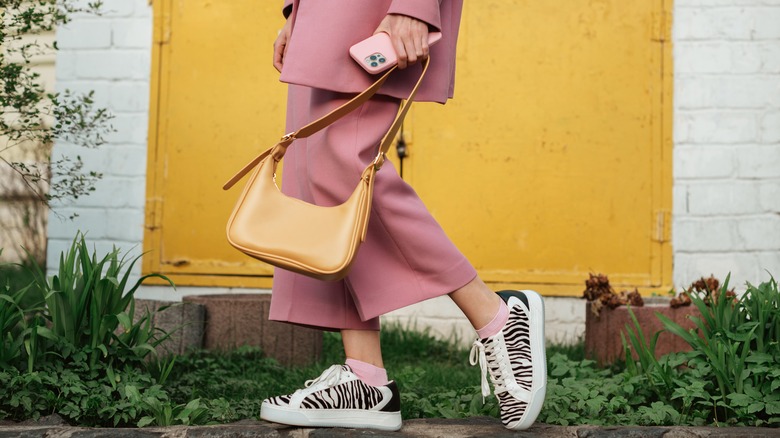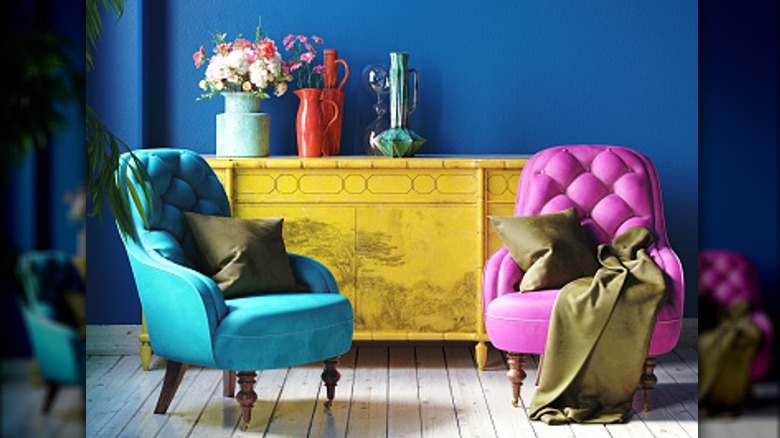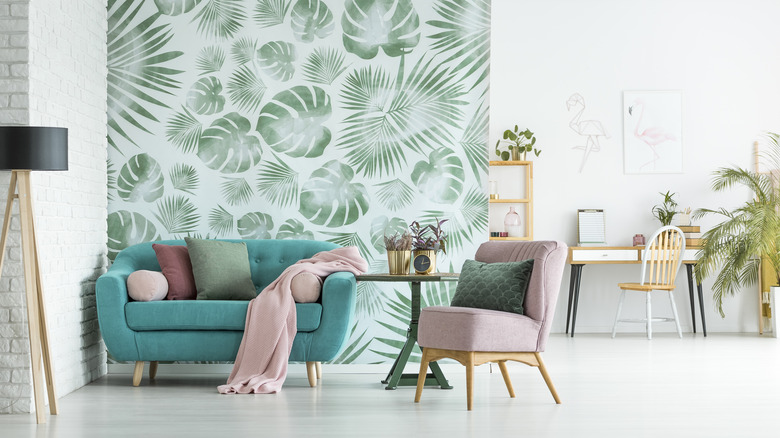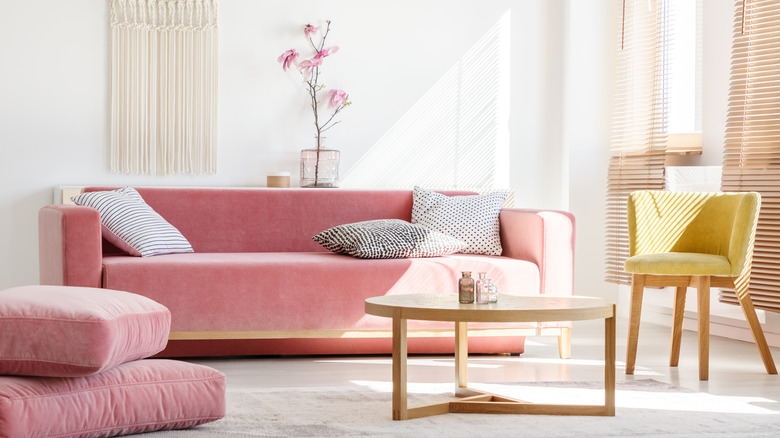What Is Dopamine Decorating And How Can It Release Your Inner Designer?
Touted as something new because it now has a buzzy name, dopamine decorating is simply a catchphrase for intuitive decorating. It describes a path to happiness at home through décor that raises our mood — a worthy concept indeed, and beyond necessary functionality, one might say the most important aspect of creating a supportive and individual space. In the mainstream, neutrals are believed safe, and color is considered bold. Likewise, objects that are playful, assertive, or unique seem risky; while versatile items go with everything, making them a good investment. Neutral interiors have been the overwhelmingly prevalent feature of furniture catalogs, social media channels, and real homes, yet shelter magazines and interior designers never really went down that muddy rabbit hole. As experts, they know that color will always be the natural language for personal and inviting spaces.
While exciting interiors felt too impractical for most of us, the general upheaval of recent years has pushed us to insist on a brighter present. "Dull and drab is no longer acceptable for those wanting to live confidently, creatively and escape the prison of the beige-box-home. [They] are recognising that their home is the foundation of a life of creativity, happiness, inspiration and joy," shares designer Sophie Robinson. Investing in the emotion a sofa creates should be on par with its adaptability. It's hard to prioritize because we can't see it; on the other hand, it's difficult to miss a vivid chair or piece of art, and that's precisely the point.
It started with dopamine dressing
The notion of dopamine decorating was inspired by fashion, as many interior design trends are, and was coined by F.I.T. fashion psychology professor Dawnn Karen. Karen is the author of "Dress Your Best Life," a book that explores how what we wear affects our state of mind. At the beginning of the COVID-19 pandemic, she wondered how we might naturally encourage dopamine release to make ourselves and others feel better. "What about wearing something crazy, whimsical stuff that doesn't match, polka dot or leopard print, tutus, or bright colors?" Karen relayed in Byrdie. She adapted the phrase "mood enhancement dress" to "dopamine dressing," and the alliterative term took off.
According to the Harvard Medical School, dopamine is the "feel-good" neurotransmitter that helps us experience pleasure, and it also affects motivation, learning, sleep, heart rate, and additional physical functions. Dopamine levels are connected to how we relate to our physical environment, including visually via color or tactilely through touch, consequently influencing our behavior and mood. Comfort and authenticity are central to positive sensations. The founder of the website Fashion is Psychology, Shakaila Forbes-Bell, explains that our associations with particular colors are individual, and she enjoins us to pay attention to the responses they elicit in us. "Add more of your favourite colours into your wardrobe –- the colours that remind you of a happier time, a place or a person," Forbes-Bell says. "Figure out what you associate with confidence and joy –- and wear it!"
The practical applications
Regarding home décor, color consultant Suzy Chiazzari shares a similar sentiment in Hello!, "Dopamine décor can be interpreted as using colour, pattern and tactile furnishings in your home as a way to make you feel happier." She adds, "Colour is emotive and personal, and we all react to colours differently," explains Chiazzari. "Choosing colours that connect with the emotions you want to experience will ultimately help you 'dopamine dress' your home." Sunny yellow, tangerine, hot pink, and sky blue are hues she suggests for their positive, energizing, romantic, and relaxing characteristics, respectively.
Kelly Collins, interior design expert at Swyft, said in Real Homes, "We're definitely seeing people being bolder and braver with their design decisions. Before people usually chose a neutral sofa and bright cushions, but now it's the other way around. Sales of our brightest orange sofa have shot up since the start of the year." However, according to Refinery29, while bright colors are getting all the attention, we're actually leaning toward more subtle shades like lilac, grayed pastels, and warm-toned pale pinks. The outlet advises a base of softer hues with jolts of stronger color for vitality and levity. For example, a muted jade green as an enveloping wall paint for the aforementioned orange sofa, a grounding, predominantly neutral area rug, and accent pillows or artwork to impart punch with a pattern or a third hue. It's an approach for incorporating dopamine-inducing shades into our décor that is livable and has longevity.
It has natural ties to biophilic design
Don't dismiss the power of plants to breathe freshness into a room. Biophilic décor and design originated in the decades-old, now-proven theory that humans are connected to nature and that exposure to its environments has an affirming influence on our emotions. Greenery and flowers contribute texture, color, and scent, and they possess a beautiful and organic mystique; further, certain plants improve indoor air quality.
The visual boost from coral roses, lemon forsythia, or bubble-gum pink hydrangeas cannot be oversold. According to Texas A&M University, flowers in the home lower stress-related depression and anxiety and make us feel happier. "Different properties of plants, such as how they look, smell and feel, impact us in so many ways. They can feel good to the touch, make a space more fragrant and please our eyes," said Mengmeng Gu, an associate professor of horticultural sciences at Texas A&M University via The Washington Post. But their effect goes beyond pleasure; "Plants also have a huge restorative capacity," Melinda Knuth, an assistant professor of horticultural science at North Carolina State University, explains in the outlet. "Whether it's outdoors like in a yard or indoors with houseplants, nature can help us feel recharged and grounded."
It's no coincidence that shades of green, blue, and earth-toned pinks are some of the most popular paint colors in recent years, providing a tie to the natural world and a compelling foundation for brighter accents.
How to use the term for good
Momtaz Begum-Hossain, the author of "Hello Rainbow –- Finding Happiness in Colour," advises in Cosmopolitan that we select hues in our home dependent upon the activities for each space. For example, lively red is a great color in the kitchen, orange is appropriate for social areas, and shades of blue fit a restful bedroom. It may be difficult to pin down a particular style, but it's fairly simple to imagine how a room should make us feel. Deciphering which colors evoke those emotions for us helps in developing a color palette. Many designers suggest that starting with an area rug offers an excellent reference point for color selections; plus, it provides instant coziness and texture.
Don't limit the interiors to solid walls; wallpaper introduces pattern and dimension. 'Walls are the largest surface area in your home, so adding interest and expressing personality here is key," shares Martin Waller, founder of Andrew Martin in House Beautiful. As with color, people have preferences and dislikes for certain prints, and they're an impactful way to sway the vibe. Patterns can also cover sofas and drapes or be distributed by small degrees with artwork, accent pillows, or tableware.
Per The Every Girl, we should only decorate with what we love, trust our instincts, and always throw in a surprise. Additionally, choose comfortable fabrics and furniture we have a hard time leaving. Don't worry too much about breaking the rules. And pay the design fee in flowers.




